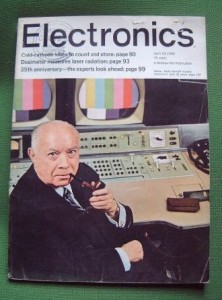 In an April, 1965 issue of Electronics Magazine, Intel co-founder Gordon Moore stated that the complexity of integrated circuits would double in 24 months. Douglas Englebart had also made a similar observation earlier, but Moore expounded on it in the magazine article, saying that by 1975 the number of components per integrated circuit for minimum cost will be 65,000 and that they would fit on a single wafer. It was later called “Moore’s Law” by Caltech professor Carver Mead.
In an April, 1965 issue of Electronics Magazine, Intel co-founder Gordon Moore stated that the complexity of integrated circuits would double in 24 months. Douglas Englebart had also made a similar observation earlier, but Moore expounded on it in the magazine article, saying that by 1975 the number of components per integrated circuit for minimum cost will be 65,000 and that they would fit on a single wafer. It was later called “Moore’s Law” by Caltech professor Carver Mead.
The popular formulation is the doubling of transitors on integrated circuits, but by the end of the 70s it was the limit for the number of transistors on the most complex chips. It is also common to cite Moore’s law to refer to the rapidly continuing advance in computing power per unit cost.



